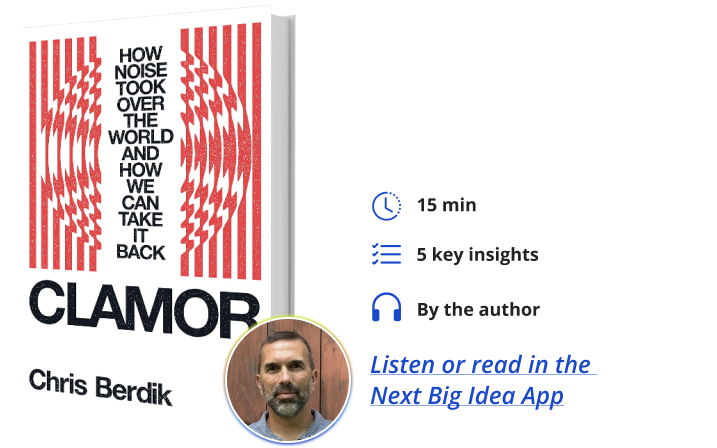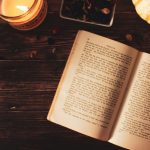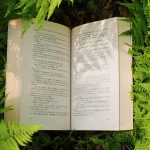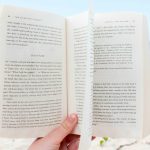Chris Berdik is a science and education journalist. His work has appeared in Popular Science, Wired, Politico, and elsewhere. He has also been awarded reporting grants from the Pulitzer Center and the Society of Environmental Journalists.
What’s the big idea?
The soundscapes we inhabit are important, not only for superficial comfort, but for long-term physical and mental wellbeing. Falling asleep next-door to a roaring highway has consequences. A cacophony that never stops shrinks the sensory world of animals that depend on hearing to survive. An excessive number of meaningless beeps and signals in a hospital, restaurant, or at home from our phones is psychologically detrimental. Productivity can plummet when an office environment is full of distracting noise. There is a long laundry list of sonic grievances, but noise control doesn’t have to be a negative, reactionary effort. We can proactively design the auditory experience of places we build in ways that make our noisy world sound less bad, or even better.
Below, Chris shares five key insights from his new book, Clamor: How Noise Took Over the World – and How We Can Take It Back. Listen to the audio version—read by Chris himself—in the Next Big Idea App.

1. Decibels are not noise.
In 1930, a truck drove all over New York City, covering over 500 miles on a mission to slay the rising urban din. The truck made stops at noise hotspots, and noise fighters made more than 10,000 sound measurements. They were armed with the latest acoustic gadgetry donated by Bell Labs, which had also devised the most powerful weapon in their arsenal: the decibel.
Introduced a few years earlier, the decibel was initially used to calculate the signal power loss across telephone cable miles. But thanks to the noise truck measurements, which led to a report by New York City’s public health commission and the world’s first municipal noise code, the decibel would become the noise measurement—in laws, standards, and popular understanding. Does a sound qualify as noise? Is it potentially harmful? Is it a sound that should concern engineers, architects, or city planners? The answers were to be found on a decibel meter.
And yet, decibels describe just one small sliver of sound—specifically, acoustic energy intensity, which roughly translates to our perception of loudness. Decibels do matter, especially at high levels of exposure that can damage hearing. But describing all noise with decibels is like the proverbial blind men trying to understand an elephant based on the small bit each of them can grasp. It’s led us to underestimate and misdiagnose noise problems and miss opportunities for creative, proactive solutions.
The “alarm fatigue” plaguing hospitals is about the sheer number of trivial or false alarms sounding in clinicians’ ears, not how loud they are. Likewise, coworker chatter in open-plan offices drives us crazy because our attention latches onto intelligible human voices. At the same time, the same decibel level of a background sonic churn is easily ignored. The most harmful noise pollution in nature isn’t the loudest, but rather chronic noise that never shuts up, shrinking the sensory worlds of animals that rely on hearing to survive.
2. Noise is more than unwanted sounds; it’s unwanted signals.
To make the case that the world is getting noisier, many writers (including me) will cite decibel-based evidence, such as spikes in restaurant loudness, the need to crank up emergency sirens to overcome a rising city din, or vanishing natural quiet. But arguably the most significant noise problem is the shattering of our focus from an onslaught of unwanted signals at any decibel level, including zero. The most challenging quiet to achieve is a quiet mind.
There are more than metaphorical connections between audible noise and what Princeton University historian Emily Thompson called the online cacophony of overstuffed email inboxes and endless social media scrolls. Not only do digital notifications claim our attention with countless pings, beeps, and chimes, but an overload of signals—audible or not—depletes our limited attentional resources.
“The most challenging quiet to achieve is a quiet mind.”
Unfortunately, we have a love-hate relationship with the noise of distraction. As much as we crave quiet, we also kind of fear it. According to a 2014 study by researchers at the University of Virginia and Harvard, people would rather administer painful electric shocks to themselves than sit silently in a room, alone with their thoughts for 15 minutes.
As Norwegian explorer Erling Kagge recalled from the weeks he spent alone crossing Antarctica under his own power, “The biggest challenge is to get up in the morning when the temperature is fifty degrees below freezing. The next hardest challenge? To be at peace with yourself.”
3. Hearing damage from noise starts earlier and goes deeper than an audiogram can detect.
Audiograms are the standard screening for hearing loss. We’ve all experienced wearing those earphones and raising our hands when we hear the beeps across a range of frequencies. A person with “normal hearing” can detect those beeps at 25 decibels, but a person with measurable hearing loss at any given frequency can’t detect the beep until the volume is turned up, at least to 30 decibels, if not a lot higher.
But there’s a massive gap between perceiving sound and truly hearing. What we experience as functional hearing requires our brains to sort through and make sense from a barrage of audio signals. As Charles Liberman, a leading hearing loss researcher at Mass Eye and Ear, said, “We hear with our brains, not with our ears.” If we screened for vision loss in the same way we do hearing loss, he continued, eye doctors would ask patients if they detected anything at all on the next line down of the eye chart, never mind reading out the specific letters and numbers.
“There’s a massive gap between perceiving sound and truly hearing.”
Studies by Liberman and his colleagues have shown that ears can still reliably detect low-decibel beeps even after noise damages their ability to transfer finer-grained auditory information to our brains. The result, which they call “hidden hearing loss,” is most keenly felt when we are trying to have a conversation with somebody in a noisy environment such as a busy restaurant.
In this scenario, your brain needs to not only perceive the sounds coming out of your companion’s mouth, but to distinguish her voice from other sounds…from the piped-in music to the clatter of dishes to every other voice within earshot. This doesn’t just depend on the relative loudness of the competing sounds; it depends on things like the subtle distinctions in different voices, the timing cues that help us localize sounds, and the limits of our auditory attention.
4. Noise hurts health, well beyond hearing.
Noise doesn’t need to be super loud to pile on chronic stress and sleep disruptions, both of which are dangerous to our health. Studies routinely show that people living in areas with a lot of moderate-decibel noise—often close to highways, airports, and other transportation sources—are more likely to develop hypertension and heart disease and experience heart attacks and strokes. The European Environment Agency implicates noise exposure in more than 48,000 new cases of heart disease every year and about 12,000 preventable deaths across the continent.
While most of these studies show correlation and not necessarily causation, newer research is connecting the biological dots between noise and poor health. For instance, recent full-body PET-scan studies by cardiologists at Massachusetts General Hospital found that over a span of seven years, people living in noisy neighborhoods were nearly twice as likely to develop heart trouble. Importantly, the scans also revealed that these folks had more highly active amygdalas (the brain area linked to fight-or-flight response) and more activity in the spleen and vertebral bone marrow (two key sources of white blood cells that help the body fight off disease but can contribute to artery-clogging inflammation when chronically triggered).
“Newer research is connecting the biological dots between noise and poor health.”
A few years ago, the accumulating evidence of noise pollution’s widespread harms to health led the American Public Health Association to propose that the definition of noise change from unwanted sound to “unwanted and/or harmful sound.” Their announcement cited numerous studies showing how noise can harm health, no matter what we think of the sounds.
5. One of our biggest noise problems is sonic shortsightedness.
Traditional noise control is vital, but it’s also limited because it’s constantly reactive and based on complaints. Rather than considering sound broadly and proactively as we design buildings, develop products, and plan cities, noise control always plays catch-up—telling people to shut up and never taking opportunities to avoid noise problems and become a positive movement for something beyond whac-a-moling decibels.
Sonic shortsightedness refers to ignoring or discounting the implications of sound and noise in the planning or design of buildings and cities. Open-plan offices promised to boost collaboration, but studies show they often fail to deliver on that promise, and the noise decreases workers’ productivity and increases their likelihood of taking sick days.
Restaurant noise is another example. The restaurant noise boom really took hold in the late 1990s, when trendsetting eateries in Manhattan started to turn up the high-energy music played in dining areas while removing upholstery, drapes, and other sound-absorbing décor in favor of hard, reflective surfaces and plopping open kitchens amongst their diners. Acousticians are increasingly being hired to fix the resulting cacophony, because noise has become a perennial top complaint among diners and a health hazard for restaurant staff.
Fixing noise problems costs a lot more than avoiding them in the first place. Thankfully, finding an acoustic sweet spot is increasingly achievable with the help of 3D acoustic models that allow people to listen to a planned restaurant, office, or any other space before it’s built. These models layer in sound sources, tweak the design and materials, and add subtle sound absorption until the resulting soundscape feels just right.
Enjoy our full library of Book Bites—read by the authors!—in the Next Big Idea App:






























